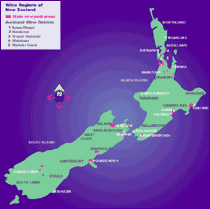
|
New
Zealand Pinot Noir: tasting 25 of the best
The problem has been that most new world sites are too warm,
resulting in over-ripe, jammy wines. And early attempts with cooler
climates often had a streak of under-ripe, herbaceous character.
Unpleasant. Then thereís the winemaking: one common fault has been
to produce wines that are too big and extracted, with none of the
finesse and subtlety that great Red Burgundies are well known for.
Things have moved on, though, and there are many fine Pinots being
produced in cooler regions in Australia and the USA. The big question,
however, is whether their hit rate is as good as New Zealandís. I
doubt it. Pinot Noir is the most widely planted red variety in NZ with
just under 1400 ha of vines. For purposes of comparison, this is about
half the area occupied by Sauvignon Blanc, the current star of the NZ
winemaking scene. Itís debatable whether NZ Pinot will ever eclipse
NZ Sauvignon in the imagination of the wine drinking public, but it
certainly has the potential to be bigger than Chardonnay, not in terms
of quantity (Chardonnay is NZís most planted grape variety), but in
quality and interest. Remember that NZ is still quite a young wine
producing country Ė the number of vineyards has more than doubled
over the last decade. With further growth and expansion likely over
the next few years, itís likely that Pinot Noir will become
increasingly important. Now to the wines. Overall, the standard was very high. Three
were rated very good, and 8 very good+. As many as 11 received the
rating of 11 very good/excellent, with three attaining the
rarely-awarded assessment of excellent. While there was plenty of
stylistic variation, the winemaking stamp wasnít overpowering, and
none of the wines was smothered in new oak. Personally, Iíd like to
see wines with more earthiness and minerality, and perhaps a little
less colour extraction: winemakers donít need to be quite so afraid
of lighter-coloured wines. But Iím being picky, and it may well be
that my preferences as a geek differ from those of many customers.
These wines arenít cheap Ė Pinot Noir seldom is Ė but they offer
pretty good value for money, with most hovering in the low to mid
teens. ...to the wines Back to top |
